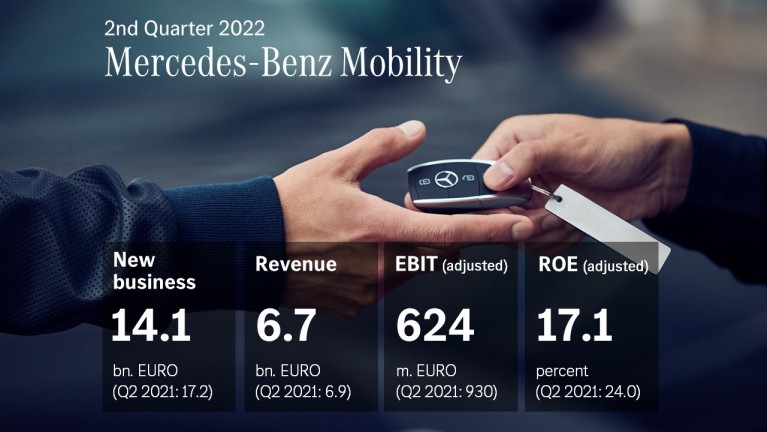
Mercedes-Benz Mobility AG
Siemensstr. 7
70469 Stuttgart
Deutschland
Tel.: +49 711 17 0
E-Mail: mobility@mercedes-benz.com
Please send queries about content on this website to any contact. You can address your concerns to us in English and your respective national language.
Represented by the Board of Management: Franz Reiner (Chairman), Jörg Lamparter, Susann Mayhead, Tolga Oktay, Peter Zieringer
Chairman of the Supervisory Board: Harald Wilhelm
Commercial Register Stuttgart, No. HRB 737788
VAT registration number: DE 81 11 20 930

Mercedes-Benz Group AG achieved strong second-quarter financial results, thanks to sustained demand for luxury vehicles and premium vans, a good model mix, enhanced pricing power and ongoing cost discipline. As a result, the adjusted Return on Sales at Mercedes-Benz Cars rose to 14.2% in the quarter and reached 10.1% at Mercedes-Benz Vans, despite the COVID lockdowns, the ongoing semiconductor supply-chain bottlenecks and war in Ukraine.


"The team at Mercedes-Benz delivered another strong quarter in an uncertain environment. We are enhancing our vigilance and resilience to manage increasingly complex macroeconomic and geopolitical challenges. At the same time, we have good reasons to remain confident, with ongoing strong demand, a fresh vehicle portfolio and further key product launches this year."
Ola Källenius
Chief Executive Officer of Mercedes-Benz Group AG
Group EBIT rose 11% to €5.2 billion (Q1 2021: €4.7 billion). Earnings were impacted by a positive €918 million gain from the sale of Canadian own retail operations and the partial sale of MB Grand Prix, nearly offsetting €709 million in expenses tied to adjustments of industrial business activities in Russia and €281 million in expenses related to diesel vehicles.
In the wake of Russia’s attack on Ukraine, Mercedes-Benz suspended the export of passenger cars, vans and spare parts to Russia and halted local manufacturing. Furthermore, the company is in close contact with suppliers that have exposure to Ukraine with a view to safeguarding supply chains. This includes among other things, transferring production to other locations within the supplier network. Mercedes-Benz has adapted shift plans at some plants and taking advantage of its flexible manufacturing system to avoid downtime and maintain production.
Mercedes-Benz reasserted its claim to leadership in the electric era. In April, the Mercedes-Benz Vision EQXX demonstrated world-beating efficiency by driving more than 1,000 kilometres on a single charge under real-world conditions. The EQS SUV was presented and the EQE was launched in the market. That’s after Mercedes-Benz opened a new battery plant in the United States in the first quarter, as part of a broader push to ramp up global production of electric vehicles this year.
The free cash flow of the industrial business in the second quarter amounted to €1.4 billion (Q2 2021: €2.2 billion), as semiconductor bottlenecks and supply-chain disruptions led to a build-up of unfinished stock. The adjusted free cash flow of the industrial business was €2.1 billion (Q2 2021: €2.5 billion). The net liquidity of the industrial business as of June 30 amounted to €19.1 billion (end of 2021: €21.0 billion).
The Group’s investments into property, plant and equipment amounted to €0.8 billion in the second quarter of 2022 (Q2 2021: €1.0 billion).
Mercedes-Benz Cars invested €0.7 billion in property, plant and equipment (Q2 2021: €0.9 billion) and Mercedes-Benz Vans invested €0.03 billion (Q2 2021: €0.03 billion).
At group level, research and development expenditure in the second quarter amounted to €2.2 billion (Q2 2021: €2.4 billion).
In the second quarter of 2022, Mercedes-Benz Mobility reached an adjusted Return on Equity (RoE) of 17.1% despite a weakening economic environment. The new business of Mercedes-Benz Mobility declined by 18% to €14.1 billion due to the impact of supply bottlenecks and the slightly decreased proportion of leased and financed vehicles in Group unit sales. Also, the prior-year figures still included the Daimler commercial vehicle business that has since been spun off and hived down. Total portfolio as of June 30 slightly increased to €135.0 billion compared to year-end 2021. Adjusted EBIT decreased to €0.6 billion driven by increased credit risk provisions due to the weaker macroeconomic outlook and by the lower volume.

Mercedes-Benz Cars sales amounted to 487,100 vehicles in the second quarter (Q2 2021: 521,200). Net pricing improved and the product mix remained favourable, helping to lift revenue by 8%, the adjusted EBIT by 20%, and the adjusted Return on Sales to 14.2%, despite a 7% drop in sales. Strong demand could not be fulfilled due to semiconductor and logistical challenges, causing unit sales in the Top-End Luxury segment to slightly decrease to 75,500 vehicles (Q2 2021: 77,900). Mercedes-Maybach posted a record quarter and S-Class sales remained very strong. Unit sales of Core Luxury vehicles exceeded those of the prior-year quarter and reached 272,600 vehicles (Q2 2021: 266,200) while 139,100 vehicles (Q2 2021: 177,100) from the Entry Luxury segment were sold during the same period. For Mercedes-Benz, the switch to electric vehicles in this segment is gathering pace, with electrified Mercedes-Benz Passenger Cars (BEV and PHEV excl. smart) amounting to 57.600 vehicles in Q2 (+16%). Fully electric vehicle sales without smart more than doubled to 25.200 (+134%).
At Mercedes-Benz Vans, second-quarter unit sales remained close to prior-year levels with 100,100 vehicles worldwide (Q2 2021: 98,400). Sales in the commercial sector rose slightly to 83,000 units while the private vans with 17,200 unit sales, remained at the prior–year level. Adjusted EBIT reached €0.4 billion (Q2 2021: €0.4 billion) thanks to strongly improved net pricing, which helped to partially offset higher raw material prices and production inefficiencies, caused mainly by semiconductor shortages. However, customer demand for electric vans, especially in the commercial sector, rose by 84% to 3,500 units driven by the eSprinter and eVito. Mercedes-Benz Vans significantly strengthened its small van portfolio with the start of customer deliveries of the new T-Class in Q2, resulting in sales of 912 units and with the new Citan, available since last year.
The geopolitical and macroeconomic conditions continue to be characterised by an exceptional degree of uncertainty, including the war in Ukraine, its impacts on supply chains, and the development of prices for raw materials and energy. Further effects due to the rapidly changing situation in Russia and Ukraine are not currently known but could possibly have substantial negative consequences for business activities, should it escalate beyond its current state.
In addition, the continued very high inflationary pressure for consumers and companies and the associated central bank increases in interest rates as well as ongoing bottlenecks in global supply chains make the outlook more difficult. Not least the further course of the pandemic, in particular in China, holds uncertainties for the expected development of the market.
Despite the macro risks, Mercedes-Benz continues to see healthy and high quality demand for its products for the second half of the year, in all core markets. Order books are solid and healthy demand is driven by a strong product portfolio which is further developing during the course of the year. Demand is seen remaining higher than supply.
The adjusted Return on Equity is seen in the range of 16% to 18%. Negative effects on EBIT are expected due to higher refinancing costs and lower contract volumes. Furthermore, the cost of credit risk is expected to trend towards its long-term average level.
Mercedes-Benz Cars continues to expect a slight sales increase. Pricing and mix are expected to remain on a high level, with top-end vehicle sales growth seen at more than 10% year-on-year.
Between January and June, Mercedes-Benz Cars achieved an adjusted Return on Sales of around 15%. For the second half of the year, it is the ambition of the company to continue with this run rate, using the levers at its disposal on top-line and cost. However, material costs, higher research and development expenses and effects from the used car business are assumed to result in a negative effect of around 2 RoS points versus the H1 run rate, in the second half of 2022. Taking into account further potential market environment headwinds related to macro uncertainties, the company's guidance for adjusted RoS for Mercedes-Benz Cars for the full-year is now at 12%-14%, rather than the 11.5% and 13% seen earlier. The target is to continue to compensate such risks through net pricing.
The cash conversion rate for Cars remains unchanged at between 0.8 to 1.0. Research and development spending is now expected to be "significantly above" the prior-year level, mainly due to the development of the MMA and AMG.EA platforms. Investments in property, plants & equipment are now expected to be "significantly below" the prior-year level, rather than "at the prior-year level."
Sales are expected to remain “slightly above” the 2021 level and the adjusted Return on Sales is expected to remain at 8% to 10%. Investments in property, plants and equipment and research and development are expected to remain "significantly above" prior-year levels due to spending to upgrade existing combustion engine platforms and to develop the electric VAN.EA platform.
Revenue this year is now seen "significantly above" the 2021 level, up from a previously expected "slightly above". EBIT is now seen "slightly above" the prior-year level, rather than "at the prior-year level". Free cash flow from the industrial business is now expected to be "at the prior-year level", from a previously expected "slightly below" the 2021 level.
Link to capital market presentation on first quarter 2022: